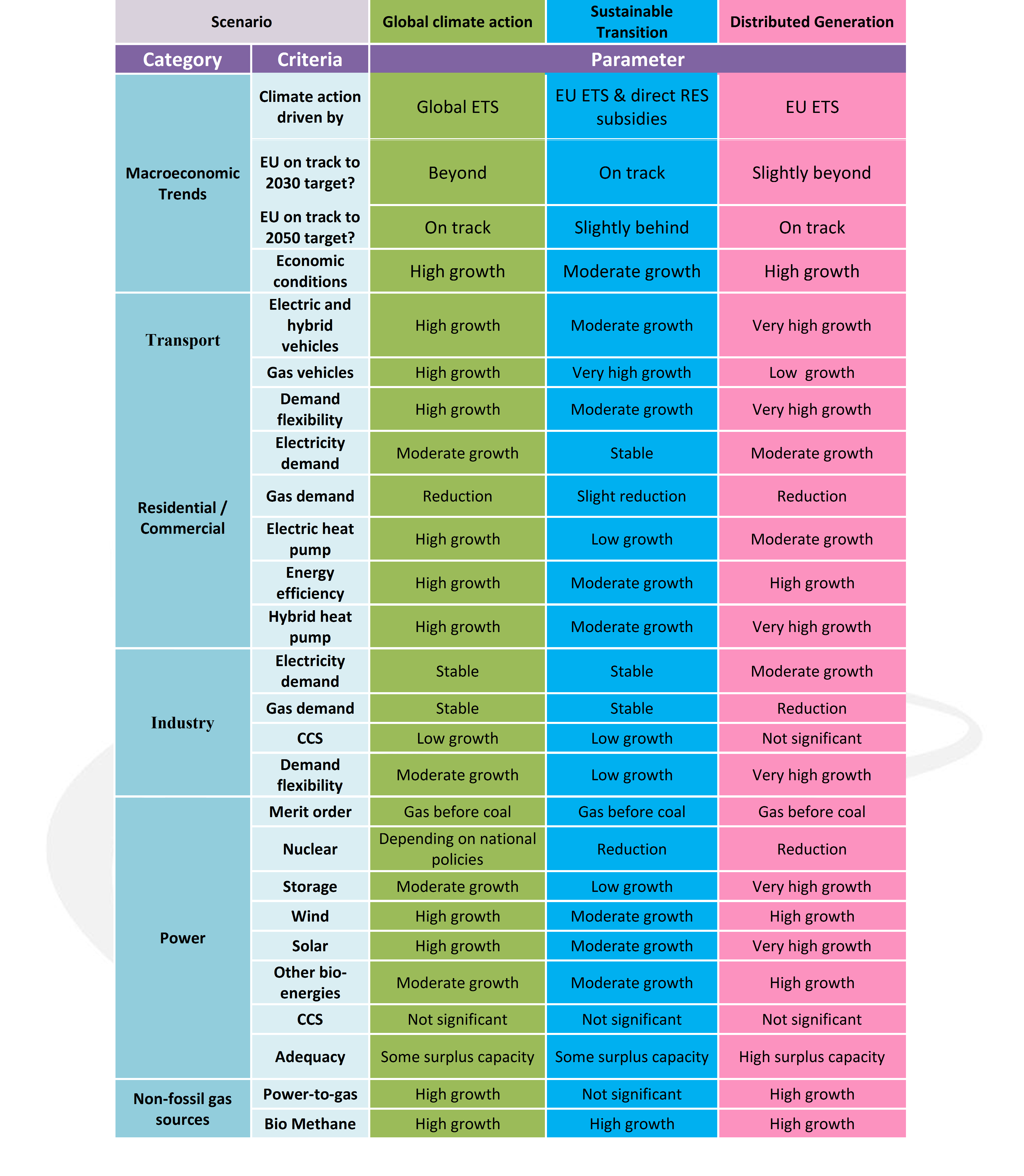Scenario description and storylines
All scenarios detail electrical load and generation, along with gas demand and supply, within a framework of EU targets and commodity prices. The full storylines, parameters and price assumptions supporting these possible futures are dealt with in this chapter. The methodology for building the scenarios is explained in Chapter 5, with further detail available in the supporting Annex document
The TYNDP scenarios include a Best Estimate scenario for the short and medium term, but three storylines for the longer term to reflect increasing uncertainties. They all are on track by 2030 to meet the decarbonisation targets set out by the EU. The scenario pathways from 2020 to 2040 can be seen in Figure 1:

Figure 1: The scenario building framework for TYNDP18. RES share of demand for electricity and gas.

Figure 2: The TYNDP18 scenarios for 2030 and 2040 are defined by three storylines.
The Best Estimate scenarios for 2020 and 2025 are based on TSO perspective, reflecting all national and European regulations in place, whilst not conflicting with any of the other scenarios. A sensitivity analysis regarding the merit order of coal and gas in the power sector is included for 2025 following stakeholder input regarding the uncertainty on prices, even in the short term. These are described as 2025 Coal Before Gas (CBG) and 2025 Gas Before Coal (GBC).
The storylines for 2030 and 2040 are:
Sustainable Transition (ST) seeks a quick and economically sustainable CO2 reduction by replacing coal and lignite by gas in the power sector. Gas also displaces some oil usage in heavy transport and shipping. The electrification of heat and transport develops at a slower pace than other scenarios. In this scenario, reaching the EU goal (80-95% CO2 reduction in 2050) requires rapid development during the 2040s to be achieved through increased technological adoption or evolution.
Distributed Generation (DG) places prosumers at the centre. It represents a more decentralised development with focus on end user technologies. Smart technology and dual fuel appliances such as hybrid heat pumps allow consumers to switch energy depending on market conditions. Electric vehicles see their highest penetration with PV and batteries widespread in buildings. These developments lead to high levels of demand side response available.
Global Climate Action (GCA) Represents a global effort towards full speed decarbonisation. The emphasis is on large-scale renewables and even nuclear in the power sector. Residential and commercial heat become more electrified, leading to a steady decline of gas demand in this sector. Decarbonisation of transportation is achieved through both electric and gas vehicle growth. Energy efficiency measures affect all sectors. Renewable gases see their strongest development within this scenario.
External Scenario:
- As part of the European Commission’s (EC) impact assessment work in 2016, EUCO 30 was a core policy scenario, created using the PRIMES model and the EU Reference Scenario 2016 as a starting point. The scenario models the achievement of the 2030 climate and energy targets as agreed by the European Council in 2014, but including an energy efficiency target of 30%. It was prepared by a consortium led by E3Mlab, hosted at the National Technical University of Athens (NTUA), and including the International Institute for Applied System Analysis (IIASA).
Upon assessment from the EC, although no scenario offered a direct comparison, it was determined that Global Climate Action was the closest representation in terms of the parameters that define the scenario. As a result, the scenario created using the input data from EUCO 30 has replaced Global Climate Action for 2030 within the TYNDP framework. However, the diverse methodologies used for deriving the scenarios may lead to differences in the continuity between this scenario and those that have been internally developed. The ENTSOs will further collaborate with the EC to improve the overall consistency shown within the Scenario Report.
Stakeholders determined with the ENTSOs the following parameters for the storylines:

Figure 3: Overview of the guiding parameters for the Scenarios